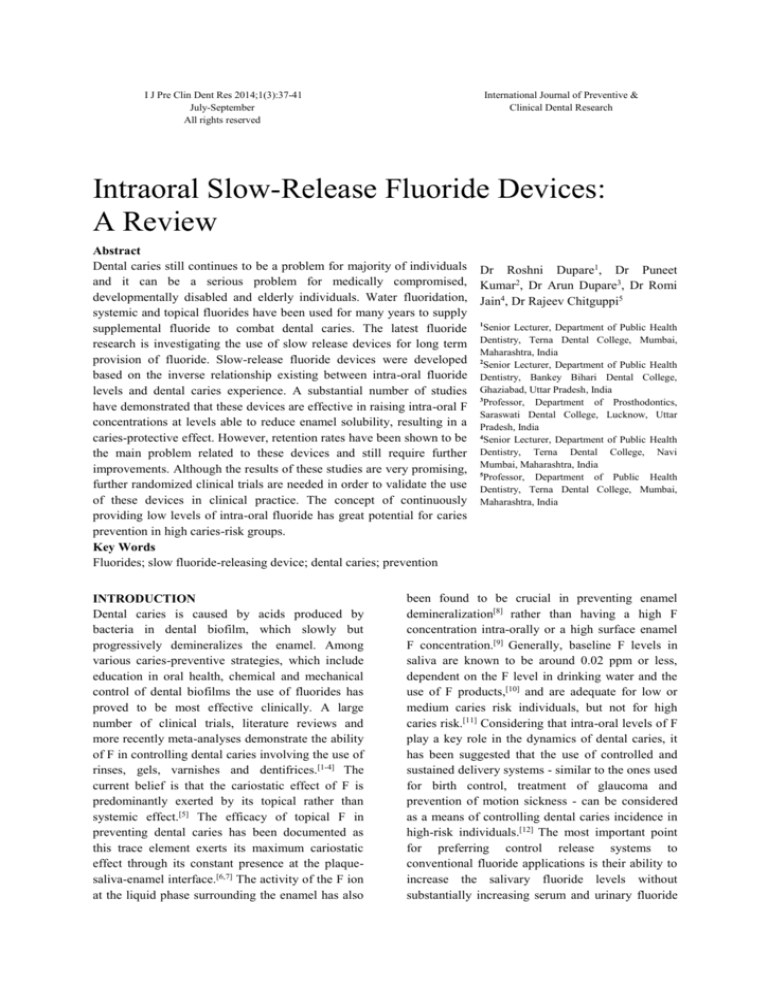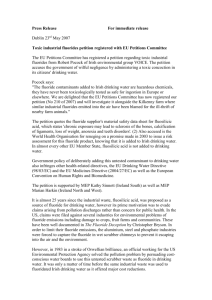
I J Pre Clin Dent Res 2014;1(3):37-41
July-September
All rights reserved
International Journal of Preventive &
Clinical Dental Research
Intraoral Slow-Release Fluoride Devices:
A Review
Abstract
Dental caries still continues to be a problem for majority of individuals
and it can be a serious problem for medically compromised,
developmentally disabled and elderly individuals. Water fluoridation,
systemic and topical fluorides have been used for many years to supply
supplemental fluoride to combat dental caries. The latest fluoride
research is investigating the use of slow release devices for long term
provision of fluoride. Slow-release fluoride devices were developed
based on the inverse relationship existing between intra-oral fluoride
levels and dental caries experience. A substantial number of studies
have demonstrated that these devices are effective in raising intra-oral F
concentrations at levels able to reduce enamel solubility, resulting in a
caries-protective effect. However, retention rates have been shown to be
the main problem related to these devices and still require further
improvements. Although the results of these studies are very promising,
further randomized clinical trials are needed in order to validate the use
of these devices in clinical practice. The concept of continuously
providing low levels of intra-oral fluoride has great potential for caries
prevention in high caries-risk groups.
Key Words
Fluorides; slow fluoride-releasing device; dental caries; prevention
INTRODUCTION
Dental caries is caused by acids produced by
bacteria in dental biofilm, which slowly but
progressively demineralizes the enamel. Among
various caries-preventive strategies, which include
education in oral health, chemical and mechanical
control of dental biofilms the use of fluorides has
proved to be most effective clinically. A large
number of clinical trials, literature reviews and
more recently meta-analyses demonstrate the ability
of F in controlling dental caries involving the use of
rinses, gels, varnishes and dentifrices.[1-4] The
current belief is that the cariostatic effect of F is
predominantly exerted by its topical rather than
systemic effect.[5] The efficacy of topical F in
preventing dental caries has been documented as
this trace element exerts its maximum cariostatic
effect through its constant presence at the plaquesaliva-enamel interface.[6,7] The activity of the F ion
at the liquid phase surrounding the enamel has also
Dr Roshni Dupare1, Dr Puneet
Kumar2, Dr Arun Dupare3, Dr Romi
Jain4, Dr Rajeev Chitguppi5
1
Senior Lecturer, Department of Public Health
Dentistry, Terna Dental College, Mumbai,
Maharashtra, India
2
Senior Lecturer, Department of Public Health
Dentistry, Bankey Bihari Dental College,
Ghaziabad, Uttar Pradesh, India
3
Professor, Department of Prosthodontics,
Saraswati Dental College, Lucknow, Uttar
Pradesh, India
4
Senior Lecturer, Department of Public Health
Dentistry, Terna Dental College, Navi
Mumbai, Maharashtra, India
5
Professor, Department of Public Health
Dentistry, Terna Dental College, Mumbai,
Maharashtra, India
been found to be crucial in preventing enamel
demineralization[8] rather than having a high F
concentration intra-orally or a high surface enamel
F concentration.[9] Generally, baseline F levels in
saliva are known to be around 0.02 ppm or less,
dependent on the F level in drinking water and the
use of F products,[10] and are adequate for low or
medium caries risk individuals, but not for high
caries risk.[11] Considering that intra-oral levels of F
play a key role in the dynamics of dental caries, it
has been suggested that the use of controlled and
sustained delivery systems - similar to the ones used
for birth control, treatment of glaucoma and
prevention of motion sickness - can be considered
as a means of controlling dental caries incidence in
high-risk individuals.[12] The most important point
for preferring control release systems to
conventional fluoride applications is their ability to
increase the salivary fluoride levels without
substantially increasing serum and urinary fluoride
38
Slow release fluoride devices
concentrations during the treatment period. Intraoral F-releasing devices have been introduced in
dentistry in an attempt to overcome the issues of
patient compliance for high caries-risk groups.
These devices are showing promising results both in
vitro and in vivo with no associated side effects and
are aimed to target high-risk groups.[13]
Development of Fluoride-Releasing Devices
One of the basic principles of delivering a drug is to
ensure provision of an adequate but non-toxic level
of drug at the intended site of action for a sufficient
duration to permit it to exert its maximum
therapeutic effect.[14] In addition to F-containing
restorative dental materials, the concept of
controlled releasing delivery systems have been
researched using three different approaches:
1. A sustained F-release from tablets/capsules,
2. An
aerosol
system
for
delivering
microcapsulated F,
3. F-releasing intra-oral devices.
The reported F release from the tablets/capsules and
aerosols was relatively short lived, while the F
devices were shown to provide significant sustained
elevation of salivary F levels for prolonged
periods.[15-17]
Different Types of Fluoride-Releasing Devices
The various types of fluoride releasing devices
described under are:
1. Copolymer membrane devices developed in
USA,
2. Glass devices that were developed in UK.
3. Hydroxyapatite-Eudragit RS100 diffusion
controlled fluoride system
4. Slow fluoride release tablets for intrabuccal
use
Copolymer membrane device: This was developed
by Cowsar et al. [1976] in the form of a membranecontrolled reservoir. It consists of an acrylic
polymer matrix impregnated with granulated
sodium fluoride (NaF) that is encased in an acrylic
polymer (membrane). The inner core consists of
hydroxyethyl
methacrylate
(HEMA)/methyl
methacrylate (MMA) copolymer (50/50 mixture)
and a precise amount of sodium fluoride (NaF). The
core is surrounded by a 30/70 HEMA/MMA
copolymer membrane, which controls the F release
rate. When the matrix becomes hydrated, small
quantities of granulated NaF are diluted until the
matrix itself becomes saturated. The matrix contains
20.3% water and the membrane contains 8.7%
water. The precise water absorption enables the
device to act accurately and reliably as a release
Dupare R, Kumar P, Dupare A, Jain R, Chitguppi R
controlling mechanism.[13] Once placed in the
mouth, the device becomes hydrated with saliva and
its characteristics lead it to release a constant rate of
sodium fluoride of 0.02-1.0mg/day for upto 4-6
months, depending on the size of the device.[18] The
device is approximately 8 mm in length, 3mm in
width, and 2 mm in thickness (Fig. 1). It is usually
attached to the buccal surface of first permanent
molar by means of stainless steel retainers spot
welded to plain, standard orthodontic bands[19] or is
bonded to the tooth surface by adhesive resin.[15] A
new holder known as CIPI made of biocompatible
elastic alloy is specifically designed for orthodontic
patients and consists of a retentive four wire cage
provided with a cannula and a clasp. The cage
contains the device and is secured by the cannula
and clasp to a molar tube.[18]
Glass device: The glass device was developed by
Curzon in 1984. The fluoride glass device dissolves
slowly when it is moist, thus releasing F without
affecting the device integrity significantly. The
original device was dome shape (4 mm in diameter)
attached to the buccal surface of first permanent
molar using adhesive resins.[21] Due to low retention
rates of the original device, it was further
substantially changed to a kidney shaped device
being 6mm long, 2.5mm wide and 2.3mm deep, and
it proved effective in both fluoride release as well as
retention rates.[21] More recently, the device has
been shaped in the form of a disk that is placed
within plastic bracket to facilitate device handling,
attachment and replacement. (Fig. 2).[18] The device
can be easily installed without the need for
debonding, removing remnants of composite resins
and performing a new acid etch to bond the device
(Fig. 3).
Hydroxyapatite - Eudragit RS100 diffusion
controlled F-system: This is the newest type of slow
release F device, which consists of a mixture of
hydroxyapatite, NaF and Eudragit RS100. It
contains 18 mg of NaF and is intended to release
0.15 mg F/day. It was demonstrated that the use of
this device is able to significantly increase salivary
and urinary F concentrations for at least 1 month.[22]
Not much information is available in the literature
about this device.
Slow fluoride release tablets for intrabuccal use:
Controlled release fluoride delivering system for
intrabuccal use was developed, permitting to reach
high enough local concentrations for desirable
therapeutic effect with minimal side effects. Tablets
of 160-200mg were formulated which were
39
Slow release fluoride devices
Fig. 1: Schematic cross-sectional view of the
copolymer device, which originally had 8 mm in
length, 3 mm in width, and 2 mm in thickness
Dupare R, Kumar P, Dupare A, Jain R, Chitguppi R
Fig. 2: The latest version of the fluoride glass slow
release device and plastic retention bracket
Fig. 3: Latest glass device and bracket
attached to upper first permanent molar tooth
intended to be fixed on a tooth. These tablets have a
granular matrix composed of pure hydroxyapatite,
Eudragit and/or ethylcellulose. NaF is added by
mechanical mixing or an impregnation method.[23]
Such a mode of fluoride administration can be
extended to all chronic pathologies of the buccal
cavity.
Applications of Intraoral Fluoride Releasing
Devices
Effect on intra-oral fluoride Concentrations:
Several in vitro and in vivo studies were conducted
in order to evaluate the resulting F levels in saliva
and dental plaque, which are the sites where the F
ion can exert its cariostatic effect during the
cariogenic challenge. Significant increases were
found in plaque F concentrations, both for the
copolymer membrane and glass devices. In a
double-blind crossover study, it was demonstrated
that the glass device significantly elevated F levels
in plaque (~ tenfold) after 1 month of placement of
the bead.[24]
Effect on Caries Prevalence Reduction: Reduction
in caries occurs due to significantly increased
salivary F levels for prolonged periods of time. The
results of a study on 174 children in UK showed
67% fewer new carious teeth and 76% fewer new
carious surfaces.[17] Mirth et al.,[25] demonstrated
55% fewer new occlusal fissures carious cavities,
showing that the constant supply of low doses of F
is able to protect not only approximal and free
surfaces, but also those not normally protected by
traditional fluoride regimens. Corpron, et al.,[26]
(1986) demonstrated that enamel can be
remineralised within 7 days after the use of a
copolymer membrane device, due to the constant
release of F ions into the oral environment. The
same authors suggested that the low F levels in
saliva allow the slow mineral uptake in the base of
the carious lesion, and not only on enamel surface,
as frequently occurs when high F vehicles are
applied.[27]
Prevention of root caries: In vivo studies showed
significantly higher fluoride uptake throughout the
entire carious lesion depth. Fluoride peaks were
present at deeper levels in the lesions treated by
fluoride devices rather than those treated with a
mouth rinses (100ppm) or a MFP dentifrice (1,000
ppm)[28] or from chewing gums.[29] This may be
attributed to the formation of calcium fluoride at the
outer surface of the lesions following the use of the
topical agents with fluoride being blocked from
penetration into the lesions body.
Medically compromised individuals: Dental caries is
a major problem in individuals with special needs
that are unable to maintain their oral health because
of disability or any debilitating condition. Intraoral
fluoride releasing devices have a substantial
40
Slow release fluoride devices
potential to inhibit caries development in these
individuals.[19]
Patients undergoing radiation therapy and
xerostomia: Patients experiencing xerostomia from
radiation therapy or cancer chemotherapy are at a
particular risk for major and minor oral
infections.[30] These devices can be of help to
patients who are more at a risk of developing dental
caries.[18]
Reduction of orthodontic white spot lesions: A
copolymer device, intended to release F for 6
months, is able to avoid the development of white
spot lesions after 1 year of using the devices by
patients under orthodontic treatment.[18]
Dentin sensitivity: In a study on subjects presenting
with dentine sensitivity, the subjects reported that
the symptoms decreased significantly, remaining
absent through the duration of the treatment after 4
weeks of using the device.[31]
Cost-Effectiveness
The F-release glass devices have a favorable
benefit-cost and cost-effectiveness ratios showing
that they are capable of providing maximum
benefits of the resources expended.[18]
Toxicity and Side-Effects of Fluoride Devices
Fluoride devices and toxicity: One of the primary
concerns about the use of the slow release fluoride
device was the possibility of de-bonding and its
subsequent ingestion, which could lead to acute
toxic effects. Thus studies have been conducted in
order to verify the degree of safety when using these
devices in humans, especially in children. No signs
of toxicity were verified in dogs after ingestion of
devices containing 6 months’ supply of fluoride
(equivalent of 458 mg F).[14] A similar finding
reported by the same authors showed no changes in
serum or urine fluoride levels in eleven subjects
who were fitted copolymer devices.[15]
Fluoride devices and side-effects: Mucosal irritation
was reported in few patients who were fitted with
copolymer devices. Erythema and/or small ulcers
were seen on the buccal mucosa opposites to the site
of the devices in some.[15] Marini[18] reported no
adverse effects of the oral tissues. Andreadis[21]
dealt with the glass-type devices in both children
and adolescents, did not report any local or systemic
effects.
CONCLUSION
The use of slow-release fluoride devices is effective
in many aspects. Its application for use in high risk
groups is considered an ideal adjunctive measure to
ensure optimum oral health. With the additional
Dupare R, Kumar P, Dupare A, Jain R, Chitguppi R
benefit of the devices being cost-effective, these
devices can be considered as ideal solution for highrisk groups who have demonstrated poor oral
hygiene and lack of motivation. High-risk groups
include patients with low socio-economic status,
ethnic minorities, special needs patients or
orthodontic patients who cannot maintain good oral
hygiene. These high caries risk groups who have
poor compliance would benefit from use of slowrelease devices.
References
1. Marinho VCC, Higgins JP, Logan S, Sheiham
A. Fluoride mouthrinses for preventing dental
caries in children and adolescents. Cochrane
Database Syst Rev 2003:CD00284.
2. Marinho VCC, Higgins JP, Logan S, Sheiham
A. Fluoride toothpastes for preventing dental
caries in children and adolescents. Cochrane
Dababase Syst Rev 2003:CD00278.
3. Marinho VCC, Higgins JP, Logan S, Sheiham
A. Systematic review of controlled trials on
the effectiveness of fluoride gels for the
prevention of dental caries in children. J Dent
Educ 2003;67:448-58.
4. Marinho VCC, Higgins JP, Logan S, Sheiham
A. Fluoride varnishes for preventing dental
caries in children and adolescents. Cochrane
Dababase Syst Rev 2002:CD00279.
5. Featherstone JDB. Prevention and reversal of
dental caries: role of low level Fluoride.
Comm Dent Oral Epidemiol 1999;27:31-40.
6. Mellberg JR, Ripa LW. Fluoride in preventive
dentistry: Theory and Clinical Applications
1983; Chicago Quintessence.
7. Ten Cate JM. Review on fluoride, with special
emphasis on calcium fluoride mechanism in
caries prevention. Eur J Oral Sci
1997;105:461-5.
8. Featherstone
JDB,
Ten
Cate
JM.
Physiochemical aspects of fluoride-enamel
interactions. Fluoride in dentistry 1988;
Chapter 6, p. 125-49.
9. Fejerskov O, Thylstrup A, Larsen MJ.
Rational use of fluoride in caries prevention.
Acta Odontol Scand 1981;39:241-9.
10. Leverett DH, Featherstone JDB, Proskin HM,
Adair SM, Eisenberg AD, Mundorff-Shrestha
SA, et al. Caries risk assessment by a crosssectional discrimination model. J Dent Res
1993;72:529-37.
41
Slow release fluoride devices
11. Featherstone JDB. Delivery challenges for
fluoride, chlorhexidine and xylitol. BMC Oral
Health 2006;15:S8.
12. Mirth DB. The use of controlled and sustained
release agents in dentistry: a review of
applications for the control of dental caries.
Pharmacol Ther Dent 1980;5:59-67.
13. Toumba KJ, Al-Ibrahim NS, Curzon MEJ. A
Review of Slow-Release Fluoride Devices.
European Archives of Paediatric Dentistry
2009;10(3):175-82.
14. Garcia CR, Siqueirose A, Benet. Oral
controlled release preparations. Pharm Acta
Helv 1978;53:99-109.
15. Mirth DB. Clinical evaluation of an intra-oral
device for the controlled release of fluoride. J
Am Dent Assoc 1982;105:791-7.
16. Kula K, Kula T, Davidson W, Parker E.
Pharmacological evaluation of an intraoral
fluoride-releasing device in adolescents. J
Dent Res 1987;66:1538-42.
17. Toumba KJ, Curzon MEJ. A clinical trial of a
slow-releasing fluoride device in children.
Caries Res 2005;39:195-200.
18. Marini I, Pelliccioni GA, Vecchiet F, Bonetti
A, Checchi L. A retentive system for intraoral
fluoride release during orthodontic treatment.
Eur J Orthod 1999;21:695-701.
19. Billings RJ, Adair S, Shields C, Moss M.
Clinical evaluation of new designs for intraoral fluoride releasing systems. Pediatr Dent
1998;20:17-24.
20. Toumba KJ, Curzon MEJ. Slow-release
fluoride. Caries Res 1993;27:43-6.
21. Andreadis GA, Toumba KJ, Curzon MEJ.
Slow release fluoride glass device: An in-vivo
fluoride release and retention of device in
children. Eur Arch Paediatr Dent 2006;7:25861.
22. Altinova YB, Alaçan A, Aydin A, Sanisoglu
SY. Evaluation of a new intraoral controlled
fluoride
release
device.
Caries
Res
2005;39:191-4.
23. Diarra M, Pourroy G, Boymond C, Muster D.
Fluoride controlled release tablets for
intrabuccal use. Biomaterials 2003;24;12931300.
24. Kapetania I. Effect of fluoride slow release
glass devices on salivary and plaque levels of
fluoride, calcium and phosphorous [thesis].
Leeds (UK): University of Leeds; 2004.
Dupare R, Kumar P, Dupare A, Jain R, Chitguppi R
25. Mirth DB, Adderly DD, Amsbaugh SM,
Monell-Torrens E, Li SH, Bowen WH.
Inhibition of experimental dental caries using
an intraoral fluoride-releasing device. J Am
Dent Assoc 1983;107:55-8.
26. Corpron RE, Clark JW, Tsai A, More FG,
Merrill DF, Kowalski CJ, et al. Intraoral
effects of a fluoride-releasing device on acid
softened enamel. J Am Dent Assoc
1986;113:383-8.
27. Corpron RE, More FG, Mount G. Comparison
of fluoride profiles by SIMS with mineral
density of subsurface enamel lesions treated
intraorally with a fluoride releasing device. J
Dent Res 1992;71:828-31.
28. Corpron RE, More FG, Beltran ED, Clark JW,
Kowalski CJ. In vivo fluoride uptake of human
root lesions using a fluoride-releasing device.
Caries Res 1991;25:158-60.
29. De Los Santos R, Lin T, Corpron E, Beltran D,
Strachan S, Landry A. In situ remineralisation
of root surface lesions using a fluoride
chewing gum or fluoride releasing device.
Caries Res 1994;28:441-6.
30. McDonald E, Marino C. Dry mouth:
Diagnosing and treating its multiple causes.
Geriatrics 1991;46:61-3.
31. Marini I, Checchi L, Vecchiet F, Spiazzi L.
Intraoral fluoride releasing device: a new
clinical therapy for dentine sensitivity. J
Periodontol 2000;71:90-5.





